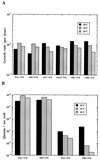A new niche for Vibrio logei, the predominant light organ symbiont of squids in the genus Sepiola
- PMID: 9422593
- PMCID: PMC106849
- DOI: 10.1128/JB.180.1.59-64.1998
A new niche for Vibrio logei, the predominant light organ symbiont of squids in the genus Sepiola
Abstract
Two genera of sepiolid squids--Euprymna, found primarily in shallow, coastal waters of Hawaii and the Western Pacific, and Sepiola, the deeper-, colder-water-dwelling Mediterranean and Atlantic squids--are known to recruit luminous bacteria into light organ symbioses. The light organ symbiont of Euprymna spp. is Vibrio fischeri, but until now, the light organ symbionts of Sepiola spp. have remained inadequately identified. We used a combination of molecular and physiological characteristics to reveal that the light organs of Sepiola affinis and Sepiola robusta contain a mixed population of Vibrio logei and V. fischeri, with V. logei comprising between 63 and 100% of the bacteria in the light organs that we analyzed. V. logei had not previously been known to exist in such symbioses. In addition, this is the first report of two different species of luminous bacteria co-occurring within a single light organ. The luminescence of these symbiotic V. logei strains, as well as that of other isolates of V. logei tested, is reduced when they are grown at temperatures above 20 degrees C, partly due to a limitation in the synthesis of aliphatic aldehyde, a substrate of the luminescence reaction. In contrast, the luminescence of the V. fischeri symbionts is optimal above 24 degrees C and is not enhanced by aldehyde addition. Also, V. fischeri strains were markedly more successful than V. logei at colonizing the light organs of juvenile Euprymna scolopes, especially at 26 degrees C. These findings have important implications for our understanding of the ecological dynamics and evolution of cooperative, and perhaps pathogenic, associations of Vibrio spp. with their animal hosts.
Figures


References
-
- Altschul S F, Gish W, Miller W, Meyers E W, Lipman D J. Basic local alignment search tool. J Mol Biol. 1990;215:403–410. - PubMed
-
- Bang S S, Baumann P, Nealson K H. Phenotypic characterization of Photobacterium logei (sp. nov.), a species related to P. fischeri. Curr Microbiol. 1978;1:285–288.
-
- Baumann P, Baumann L, Bang S S, Woolkalis M J. Reevaluation of the taxonomy of Vibrio, Beneckea, and Photobacterium: abolition of the genus Beneckea. Curr Microbiol. 1980;4:127–132.
-
- Bello G. A key for the identification of the Mediterranean sepiolids (Mollusca: Cephalopoda) Bull Inst Oceanogr Monaco. 1995;16:41–55.
-
- Bhaud M, Jacques G, Razouls C. Données météorologiques et hydrologiques de la région de Banyuls-sur-Mer, 1965–1966 (point côtier) Vie Milieu. 1967;18:137–151.
Publication types
MeSH terms
Substances
Grants and funding
LinkOut - more resources
Full Text Sources
Miscellaneous

